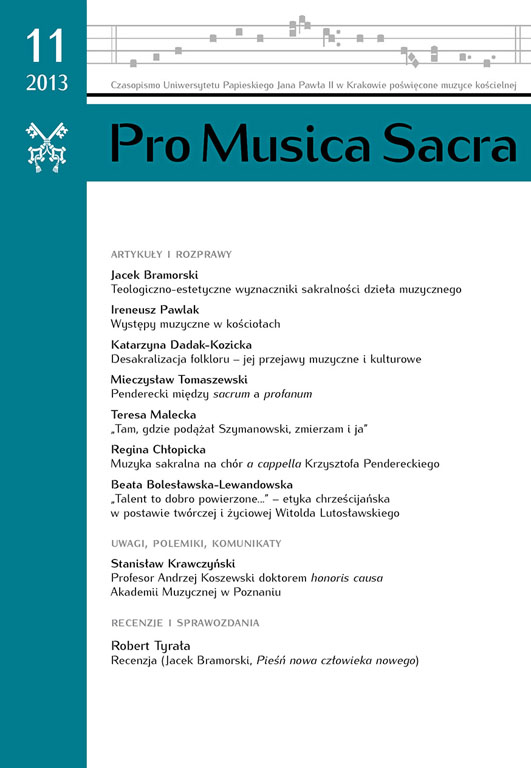Wymagania teologiczne odnośnie do miejsca celebracji liturgicznej
DOI:
https://doi.org/10.15633/pms.553Słowa kluczowe:
budynek sakralny, poświęcenie kościoła, cechy budynku kościołaAbstrakt
Talking about music in a sacral space is without doubt necessary to look deeply into the meaning of church building itself. Purpose for which is serving, formats its structure and equipment. In the article reflection was founded on the testimony of christian community of the first centuries and on the texts in the present Pontifical, which is used during dedication of the church and the altar. Christians in the first centuries during designing of the churches distains themselves from pagan buildings and also from the Temple in Jerusalem. They emphasize the spiritual side of their worship. They needed only the building where they could meet together, because the community was the real temple of God. So they gather simply very often in a bigger house or sometimes in a synagogue.
The building of the church in a landscape of the towns and villages is undoubtedly the sign. It says by itself about unceasing God’s care for human being. The mystery of Incarnation is the base of the truth that God reveals Himself in a creation. That’s why for believers, although not only, it is the place of the presence of God who saved man. The community lives by celebrating, and they are hold in the church. Church becomes the sign of close relation between God and man.
Today is required that the church building should have all what is necessary for celebration. Only that building can be blessed and serve for christian cult. The most important elements of equipment are altar, pulpit and place for leading. It is also necessary to notice and have the proper place for organ, choir and acoustic. Undoubtedly the mark of the church should be inert noble beauty.
The sanctity of the church building depends on mystery of the presence of God in certain place. Through holding in it the sacred rites it becomes holy but it can lose holiness if it is used for different purpose.
Pobrania
Opublikowane
Numer
Dział
Licencja
Prawa autorskie (c) 2013 Stanisław Mieszczak

Utwór dostępny jest na licencji Creative Commons Uznanie autorstwa 4.0 Międzynarodowe.
Autorzy publikujący w czasopiśmie udzielają jego wydawcy zgody o następującej treści:
- Autor zachowuje autorskie prawa majątkowe do utworu, a jednocześnie udziela wydawcy czasopisma zgody na jego pierwszą publikację w wersji drukowanej i wersji online na licencji Creative Commons Uznanie autorstwa 4.0 Międzynarodowe oraz zgody na wykonywanie opracowań, w tym przekładów.
- Autor ma możliwość udzielania zgody niewyłącznej na opublikowanie utworu w wersji, która ukazała się w czasopiśmie (np. zamieszczenia go w repozytorium instytucjonalnym lub opublikowania w książce), wraz z informacją o jego pierwszej publikacji w czasopiśmie.
- Autor może umieścić swój utwór online (np. w repozytorium instytucjonalnym lub na swojej stronie internetowej) jeszcze przed zgłoszeniem utworu do czasopisma.

